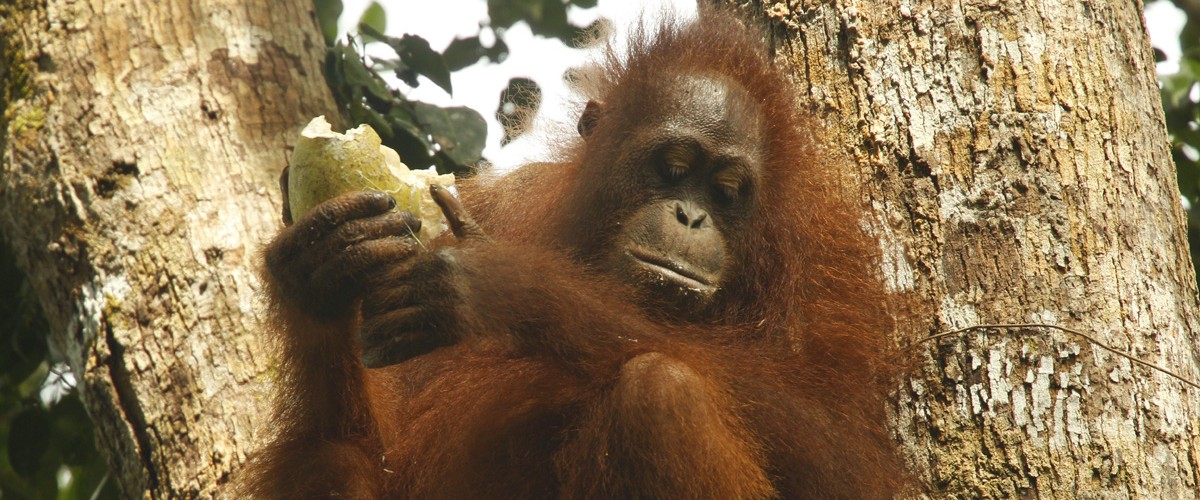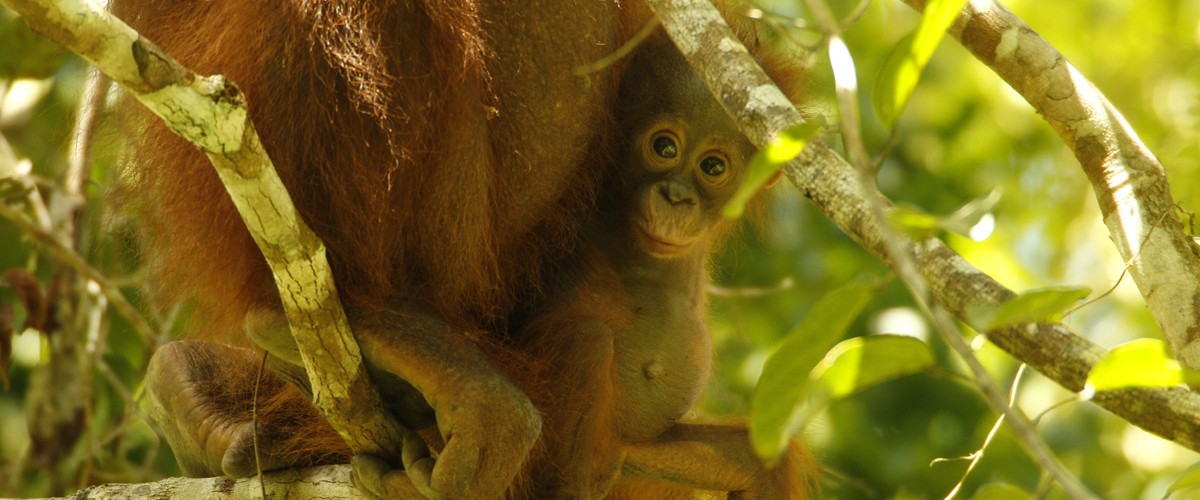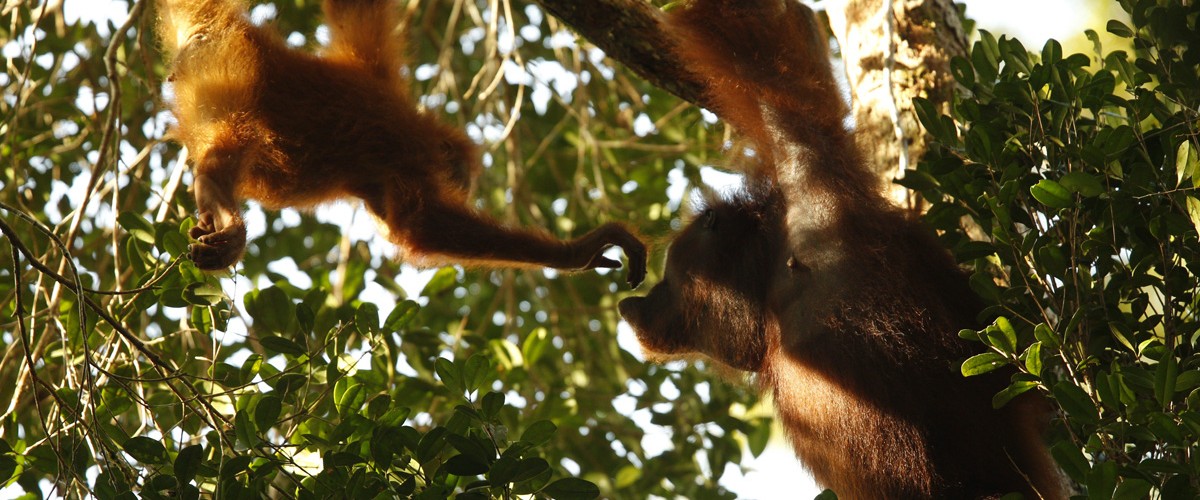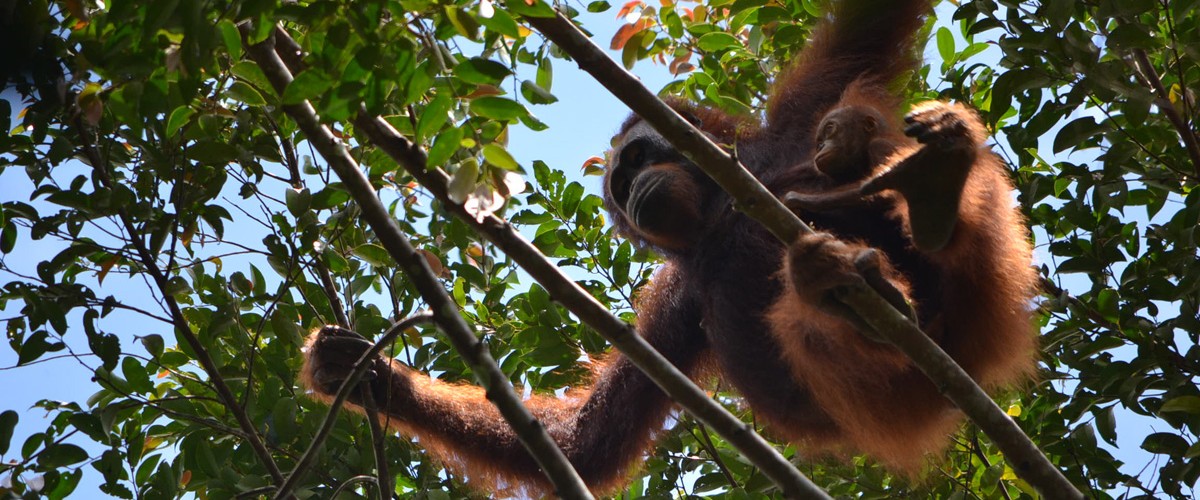By Cheryl Knott, GPOCP Executive Director
Every once in awhile instead of searching for orangutans, they come to you! To our surprise and delight, this summer one of our older females, Bibi, and her baby, Bayas, included our camp in their circuit of fruiting trees they were visiting. Imagine being able to watch orangutans while sitting on the ping pong table having your morning coffee! Bibi discovered (or probably she already knew!) that in the clearing between our camp buildings we have a selection of tasty forest fruit trees – a mango, a breadfruit and a langsat. All happened to be fruiting in July. Bibi and Bayas spent many hours feeding in these trees seemingly oblivious to our camp full of people. What a treat for the Field Course participants (led by Professor Andy Marshall and Pak Endro Setiawan from the Gunung Palung National Park office) to be able to see a mother and baby up close on their visit to Cabang Panti. We had to convince them that it’s usually not this easy!
 |
| Three-year-old male Bayas. Photo © Russell Laman |
I knew Bibi was very habituated, but I’ve never seen an orangutan so comfortable with that many people. She even made her nest a few meters away – right above the trail between the camp and the bathroom! No 3 am wake up time would be needed the next morning! It’s taken many, many years of following wild orangutans at Cabang Panti to reach the point where they will allow us to observe them at such close quarters. Orangutans are very wary of people and unhabituated individuals run away, vocalize and even throw the occasional branch at us. This doesn’t teach us much about their natural behaviors. So, we put in the many hours needed to allow them to become accustomed to our presence and to realize we are not a threat. This is one of the great values of long term research, we can follow the lives of individual animals who allow us the privilege to observe their world.
 |
| Dr. Cheryl Knott watches and orangutan with field assistant Toto. Photo © Tim Laman. |
Bibi’s world often includes her older daughter, Berani. We spent many days this summer also following Berani, and her seemingly constant companion, the unflanged male Bosman. One of the other favorite spots of the orangutans was a cluster of huge mango trees – two different species – a bit further afield from camp. Most rainforest fruits do not have domesticated varieties – but mangos are one of the exceptions. These huge, tasty fruits provided a feast for the orangutans, many times feeding on them well past dark. Although orangutans are often thought of as solitary, they do spend time together when they can, and it’s actually not unusual to see several together in a big fruit tree. They also have their own social drama – as we saw repeatedly when Walimah joined the group. Although intent on following Berani, Bosman also mated with Walimah when she’d come into the mango tree. But, Berani, wanted nothing to do with her, and would flee whenever Walimah approached, giving up her choice spot.
 |
| A view into the big mango tree! Photo © Tim Laman. |
These interactions teach us much about the relative status of the individuals in the population, with Walimah being dominant to Berani. Although the rainforest is huge, fruit trees with these big crops are not common, and may become a contested resource. This summer, however, I also witnessed an example of turn taking that I’d never seen before. One of the days when I was following Berani and Bosman, Berani spotted a small tree with ripe fruit. Climbing to the top of it, her weight nearly pulled the tree over. Bosman just sat on an adjacent tree watching her. When Berani left the tree, she swayed it back towards Bosman, climbed out over his head, and they switched places. It was his turn to feed and hers to patiently watch. They did this several times. I don’t think I’ve ever seen this kind of cooperation between unrelated adults. These great red apes teach me something new every time!
 |
| Gunung Palung Orangutan Project Research Team – Summer, 2018. Photo © Tim Laman. |









